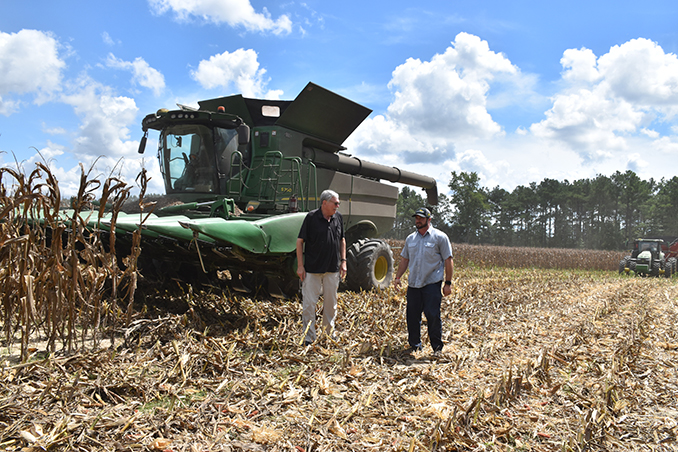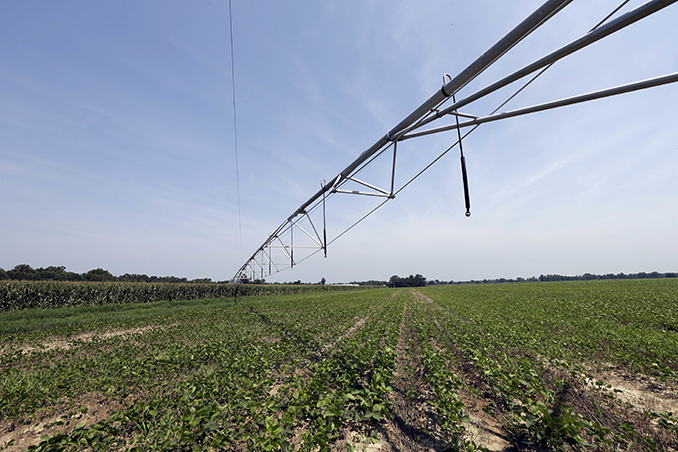
RAEFORD — As the U.S. Department of Agriculture is forecasting lower crop production in many agriculture commodities like corn and hogs, Hoke County farmers are working to maintain fields, crop, and livestock production.
Historically, Hoke County farms have produced a diverse crop each year consisting primarily of corn, soybeans, and wheat, along with cotton and peanuts. The poultry flock numbers are over 4 million, according to 2021 data. The county also produces some cattle and hogs.
The most recent agriculture census in North Carolina was taken in 2017 and showed that Hoke County has seen a reduction in the number of people farming as well as the total acreage tended.
Matt Hendrix, a local farmer in Raeford, knows the struggles of keeping farming alive in Hoke County. He represents the fourth generation of the Hendrix family farm in Hoke County.
Last week, Hendrix was cutting corn off of Neil Maxwell Road in Hoke County. The corn was bound for local mills to feed the huge livestock industry of eastern North Carolina. He said his family’s farming heritage dates back to his great grandfather, J.R. Hendrix, who started with just 100 acres, a mule, a wagon, and a house that still stands.
Now, the Hendrix family farms over 7,000 acres of corn and other crops. Earl Hendrix, Matt’s grandfather, grew the farm with tobacco, long the leading crop in Hoke County, and cotton, a staple of eastern North Carolina fields. Matt, along with his brother Evan and father, Gary Hendrix, have continued the family farming tradition and grown the farming business in size and production.
Hendrix says his family believes they must be good stewards of the land. “People now get an idea from mass media, television, or movies that we’re all out here trying to destroy the world or destroy our land,” said Hendrix. “I just want to say that if I’m going to do this for the rest of my life, I have to take care of what I have and be a good steward of the land.”
Hendrix Farms is just one of many in Hoke County that is farming approximately 30,000 acres of land in the county. According to the Hoke County Farm Services Agency, soybeans and corn are now the top crops in Hoke, with over half of the county’s planted acres in those two commodities. In 2020, Hoke County ranked 36th in North Carolina for corn production and 56th statewide for soybeans. The county’s 70,000 turkeys in 2020 marked its highest rank for any agricultural commodity at 20th in the state.
Hoke County falls outside the top ten counties in the major commodities and livestock, but agriculture still plays a significant role in the county’s economy and character. Over 10% of the land in Hoke County is devoted to agriculture production. In 2020, agriculture receipts totaled over $48 million in Hoke.
As the nation sees corn acreage down by 4% this year, hog inventory down 1%, and winter wheat off more than 8%, Hoke County farmers have an opportunity to grow in a statewide market that the North Carolina Commissioner of Agriculture says will soon exceed $100 billion.
In July, Troxler said the state’s agriculture industry stood at $92.9 billion. To be a farmer, you’ve got to be pretty optimistic when you put the first seed in the ground,” said Troxler in his “From the Tractor” column in July. “I had hoped this would be the year we saw the economic impact top $100 billion, but it is not. Regardless, I am undeterred in my belief that we will reach the $100 billion mark.”
The new census of agriculture, which is produced every five years by the U.S. Department of Agriculture, is now in the field. Troxler recently said around 87,000 known farming operations in North Carolina were mailed a questionnaire to complete the census survey. The nearly 300 farming operations in Hoke County will be part of that census which Troxler says will help his office preserve farmland and prevent losing farmers and productive acreage across the state.
Preserving farming as a way of life is something Hendrix is focused on. “I want to take care of this farm so that if my kids or their kids want to continue doing this,” said Hendrix. “It’s there for them and others to live off of.”



